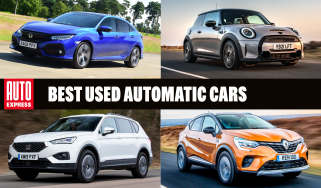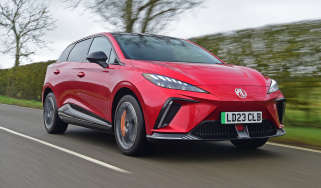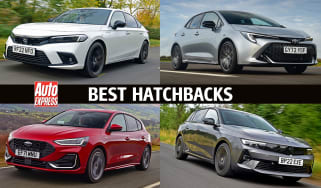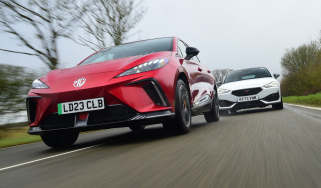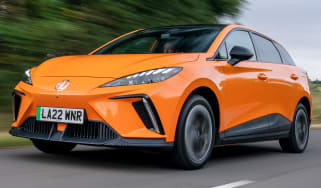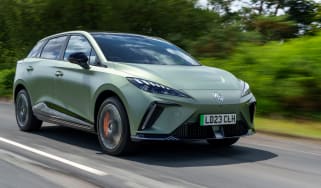MG4 EV review
The MG4 EV’s sharp styling, spacious interior and impressive efficiency mean it’s one of the best electric cars around

The MG4 is a small electric car that takes on rivals from big names including Kia, Nissan and Volkswagen – and it wins, especially when it comes to practicality, performance and value for money. Electric cars are known for being somewhat expensive, but the MG4 proves that you can get good value for money, even with an EV. It’s also available with some excellent finance deals, too.
While the interior doesn’t have the quality to match what you’ll find in rivals from Hyundai or Kia, and the boot is a little small, the MG4 is more than just a budget EV. It’s good to drive, has a decent electric range and is comfortable too. If you’re looking for a stylish small car with ultra-low running costs, it’s well worth a look.
Our choice: MG4 SE Long Range
About the MG4 EV
Generally, even a small electric car such as the Fiat 500, MINI Electric and Peugeot e-208 will cost around £30,000, which is about the same as a much larger petrol-engined family hatchback or crossover SUV. If you want to drive an all-electric family SUV, it’s even more expensive.
There are exceptions to the rule of course, and the MG4 hatchback is one of them. It starts from around £27,000, making it one of the cheapest electric cars on sale. That’s an impressive feat considering the MG4 has a much more spacious interior than those rivals mentioned above, plus it offers a similar range and extensive standard equipment list as far pricier EVs such as the Cupra Born, Renault Megane E-Tech and Volkswagen ID.3. It’s not as practical as SUVs such as the Kia Niro EV, Hyundai Kona Electric and MG's own ZS EV but the MG4 is still a capable family car and the eye-catching looks could easily tempt buyers away from these trendy models.
More reviews
So, what do you get with MG’s first from the ground up electric car? The MG4 is built on the manufacturer’s Modular Scalable Platform (MSP), which will underpin a range of MG EVs, including the MG Cyberster. The MG4 is available with three different battery sizes (51kWh, 64kWh, or 77kWh), and four different power outputs ranging from the least expensive SE with rear-wheel drive and a 168bhp motor, to the performance-oriented MG4 XPower with four-wheel drive and 429bhp.
Depending on which model you choose, the electric driving range goes from 218 miles for the 51kWh SE to 323 miles for the 77kWh Extended Range. All versions have rapid-charging capability, allowing for speedy top-ups for those looking to embark on longer journeys.
Standard equipment is generous, including the novel touch of a rear windscreen wiper to keep the back window clean, which seems to have gone missing from some EVs we could mention (we’re looking at you Ora Funky Cat). Entry-level SE cars come with 17-inch alloy wheels, automatic LED headlights, rear parking sensors, adaptive cruise control and a 10.25-inch infotainment touchscreen with Apple CarPlay and Android Auto connectivity. A large rear wing is fitted to higher-specced Trophy models to differentiate them from the rest of the range and includes luxuries such as heated seats, wireless smartphone charging and an upgraded audio system. The range-topping XPower boasts all of the goodies from the Trophy model but comes with distinctive 18-inch alloys and (mercifully) bigger brakes to handle all its extra performance.
We find that the MG4 makes much more sense as a value proposition, which is why we recommend then the SE Long Range model as the pick of the lineup, because you get everything you’ll need with a respectable electric range.
Electric motor, drive and performance
All versions of the MG4, bar the high-performance XPower, focus more on being efficient and delivering practical range, rather than outright pace. To that end, Long and Extended Range versions feature an active aero grille that only opens when the electrical systems need cooling but closes when not required to help improve the range by as much as 10 per cent.
As buyers will probably spend most of their time driving shorter journeys to perform the usual everyday tasks such as school runs and urban work commutes, it’s essential that the MG4 EV is comfortable and easy to drive. Fortunately, MG has done a fine job here, with the MG4 offering a relaxed ride that deals with speed bumps well and light, accurate steering to make parking less of a hassle. Good forward visibility and short overhangs make navigating through busy streets a bit easier. Trophy versions come with a 360-degree camera system, which is a big help to those who aren’t confident with parking manoeuvres.
But, the MG4 isn’t just suited to in-town duties; it’s more than accomplished on twisty B-roads and, dare we say it, even a little fun. It’s a tad nose-heavy, but its playful chassis and rear-wheel drive set-up mean it can be a hoot to drive on a country road if you're not too concerned about eating up a lot of your range, although you will need to turn off the intrusive lane-keeping assistance - especially on narrow country lanes – because we’ve found that the system can tug quite violently at the steering wheel as it attempts to keep you within the lines.
The MG4 XPower version loses a little bit of the standard car’s adjustability because its wider tyres offer more grip, so it feels more sure-footed and agile. Its firmer suspension leads to tighter body control, making it more stable in the bends. Plus, the additional traction of four-wheel drive allows it to put its power down better onto the road from a standing start – especially in slippery conditions. All versions are relatively settled on the motorway, but can suffer from higher wind noise around the door mirrors. Try a Renault Megane E-Tech or Volkswagen ID.3 if you're after an especially refined motorway EV.
MG has also included five driving modes to suit different conditions – Eco, sport, snow, custom, and standard, with Eco dulling the accelerator response and sport sharpening things up. Regardless of your mode, the brake pedal feel is easy to modulate, meaning you can stop smoothly in busy town traffic and accurately judge how much speed to scrub off for roundabouts.
You can bypass the mechanical brakes and utilise the car’s one-pedal regenerative braking feature. Just like in the Nissan Leaf, it’s strong enough to bring the car to a halt when you lift off the accelerator, and it has the benefit of generating electricity while slowing down to replenish the battery.
That said, rivals like the Kia Niro EV use paddles mounted on the steering wheel to adjust the regen strength, which is a much easier setup than having to dive into the MG4's touchscreen in order to adjust the brake pedal settings, along with the various driving modes. You can programme it to be a favourite on one of the star buttons on the steering wheel, if you remember to do so.
0-62mph acceleration and top speed
The MG4 is available in four power outputs: 168bhp for the entry-level SE, 200bhp for the Long Range, 242bhp in the Extended Range, topping out at 429bhp with the dual-motor, four-wheel drive XPower. Even the least powerful of the quartet is brisk enough to suit most needs, managing 0-62mph in 7.5 seconds. The more powerful 200bhp cars have a heavier 64kWh pack and are fractionally slower at 7.7 seconds. You probably won’t notice this because both feel similarly accelerative due to having the same torque figure of 250Nm, and (where legally able) can reach a 100 mph top speed. The 242bhp, 77kWh Extended Range will trouble a few hot hatchbacks with a 6.5-second 0-62mph time, while the XPower would frighten a few supercars in a straight line, with a 3.8-second 0-62mph run, though top speed is more modest, at 124mph.
Understandably, regular versions of the MG4 don’t feel as rapid as the XPower model when launching from a standstill. Still, once moving, the linear power delivery provides surprisingly strong acceleration – even past 60mph. Predictably, the XPower feels rapid, and its prodigious power reserves make it a handy overtaking weapon to safely get past slower traffic.
In the more relevant real-world benchmark of accelerating from 0-30mph – something you may need to do when accelerating from a side street onto a busy main road – the standard 168bhp model can complete this in a sprightly 3.1 seconds, while the heavier 200bhp Long Range is only marginally behind at 3.5 seconds. The Extended Range covers the dash in 2.7 seconds, while the all-wheel drive XPower takes just 1.7 seconds.
Range, charging and running costs
The entry-level MG4 SE model has a 51kWh battery and can cover up to 218 miles (according to the official WLTP figures) on a single charge. Upgrading to the SE Long Range version adds a larger 64kWh battery and boosts the range to 281 miles, while the top-of-the-range Trophy Long Range is a little behind, offering a claimed 270 miles before you need to plug in.
The Extended Range with its larger 77kWh battery extends your driving radius by over 50 miles to an impressive 323 miles. With the additional weight of four-wheel drive and its larger tyres adding extra rolling resistance compared with the skinnier wheels of regular MG4s, the 64kWh MG4 XPower manages only 239 miles.
The regular MG4 has proven itself to be pretty efficient during our own testing, returning up to 4.2 miles per kilowatt-hour of energy when we first drove the top-spec Trophy Long Range model, which equates to a real-world range of 259 miles – just 11 miles shy of the car's official range.
We’ve also pitted the same version head-to-head against a Kia Niro EV. While the Kia managed to return 3.8mi/kWh, the MG4 got 3.5mi/kWh, and we expect you'll get closer to this figure if you do a lot of motorway miles or spirited driving. Like all electric cars we've tested, the MG4 is not impervious to cold weather, managing 3.1mi/kWh during our twin test against the Ora Funky Cat in the winter. Although the Funky Cat only mustered 2.8mi/kWh in the same conditions.
Longer journeys shouldn’t prove to be too much of a chore, because the base MG4 has a maximum charging speed of 117kW, while the Long Range models top out at 135kW. That means if you plug any MG4 into an ultra-rapid charger capable of 150kW speeds or faster, which are common at UK motorway service stations these days, a 10 to 80 per cent top-up will take just over half an hour. Even the Extended Range isn’t much slower, despite the extra capacity to top up, with a 39-minute charge time from 10 to 80 per cent.
If you’re transitioning to an all-electric car for the first time and have off-street parking, it would be sensible to invest in a wallbox home charger so that you can charge your car overnight. A standard 7.4kW home wallbox will take just over eight hours to fully recharge the 51kWh battery in the base MG4, 10 hours for the Long Range MG4's 64kWh unit or close to 11 hours for the MG4 Extended Range with its 77kWh unit.
Insurance groups
As a result of higher purchase prices and increased repair costs, all-electric cars can often attract more expensive insurance premiums than petrol and diesel models. The MG4 doesn’t fare too badly here because the 51kWh SE model is in group 27 (out of 50), while the 64kWh SE Long Range and Trophy Long Range versions are in group 28 and 29, respectively. The extra power of the MG4 Trophy Extended Range increases this to 33, but that’s nothing compared with the group 40 rating for the high-performance XPower.
If you want a small EV that’s cheaper to insure, look at the Fiat 500, which starts in just group 16, or the Cupra Born in group 25.
You can get personalised car insurance quotes fast with our comparison tool powered by Quotezone...
Depreciation
As well as benefiting from the MG4’s competitive pricing, buyers will be pleased that early signs indicate the MG4 will be a strong performer on the used market. After a typical three-year ownership period and 36,000 miles, our expert data suggests it should hold on to around 66 per cent of its original value. In comparison, the Kia Niro EV retains 55-57 per cent.
To get an accurate valuation on a specific model check out our valuation tool...
Interior, design and technology
Unlike its MG ZS EV sibling, which is based on a combustion-engined model, the all-electric MG4 benefits from sitting on the manufacturer’s new Modular Scalable Platform (MSP). This architecture will underpin the next generation of battery-powered MG models, including a range of hatchbacks, SUVs and sports cars.
The exterior of the MG4 will polarise opinion, but its sharp, dramatic lines, angular headlights and twin aero rear spoiler (on Trophy versions) mean it won’t get lost in the crowd – particularly if you specify Volcano Orange, Dynamic Red or Holborn Blue colour options. MG4 XPower models also get a few new colours, as well as unique 18-inch alloy wheels and a set of orange brake calipers behind them. Inside, there’s red stitching, some aluminium pedals, and the seats get some Alcantara trim, but don’t expect the kind of bold visual cues you’d have found in MG’s range in the early 2000s – the overall look isn’t much different to the Trophy.
A minimalist, spacious cabin is in keeping with current EV fashion, while there is more than a hint that MG has drawn inspiration from premium German brands in developing the MG4’s interior style. The steering wheel has a slightly squared-off look similar in design to the one found in the BMW iX, the digital instrument display could have come from the VW ID.3, and the column stalks wouldn’t seem out of place in an Audi model. All this should be seen as a positive because MG has made a solid attempt to create a modern, up-to-date interior.
Admittedly, some of the materials do reflect the cheaper price point of the MG4 EV, with the fit and finish not entirely up to the standard of other mainstream brands such as Hyundai and Kia. But the overall impression remains positive, and the cabin looks smart enough.
Sat-nav, stereo and infotainment
The first thing that strikes you about the 10.25-inch display is how sharp the resolution is, while the row of physical buttons below are welcome. It’s also useful that there’s a row of shortcuts permanently on the right of the screen within easy reach of the driver (unlike in the Fiat 500, which places them on the far left, closer to the passenger), making it easier to get to the sat-nav, stereo, phone, and car setting screens. You can also set the air-con controls up as a shortcut from a button on the steering wheel that will allow you to adjust the fan speed and temperature using one of the thumb-controlled toggle switches.
However, we have noticed that it isn’t the most responsive screen during our long term testing. We’ve found that the menu screens can be awkward to use due to the small icons and text being hard to see at a glance while on the move. The Renault Megane E-Tech, has a much larger and more responsive screen that’s much easier to use on the move.
Apple CarPlay and Android Auto smartphone connectivity is standard, though neither is wireless. Speaking of wireless, you’ll need to get a top-spec Trophy or XPower to get a wireless phone charging pad. It is a shame you can’t add an upgraded sound system like you can on some of its rivals because you’ll need to crank up the volume at motorway speeds to offset the wind noise.
Practicality, comfort and boot space
Despite the MG4’s relatively low roof line it still offers good space inside, while there are plenty of useful storage options. Up front, there is a cubby with a sliding lid that sits just behind two cup holders, and lifting the top of the central armrest uncovers a deep bin for larger items. The glovebox isn’t very practical in terms of size or shape, but there is space in each of the front door bins for bottles and other items.
Keyless entry, automatic headlights, electrically adjustable heated door mirrors and a height and reach-adjustable steering wheel are all standard for the MG4. The top-of-the-range Trophy adds extras such as a heating function for the front seats and steering wheel, a six-way electrically adjustable driver’s seat, an adjustable boot floor and a wireless smartphone charger.
Size
The MG4 is 4,287mm long, 1,836mm wide and stands 1,504mm tall, which makes it 26mm longer and 27mm wider than Volkswagen's own electric family hatchback, the ID.3. Meanwhile the more expensive Renault Megane E-Tech is 77mm shorter and 56mm narrower than the MG4.
Leg room, head room & passenger space
Interior packaging is good in the MG4, and passengers benefit from a decent amount of rear legroom. Knee room is also fine, although there isn’t too much space underneath the front seats for your feet. The EV powertrain means that the central hump in the floor is quite low, which helps accommodate three passengers across the rear seats – the middle of which is surprisingly comfortable.
We found access to the ISOFIX mounting points was awkward when fitting a child seat; we prefer the plastic surrounds used by the likes of VW rather than the large velcro fabric panels featured in the MG4.
Boot
With a luggage capacity of 363 litres, the MG4’s boot isn’t the biggest in its class. Both the VW ID.3 and Cupra Born offer 22 litres of extra cargo space, while the Megane E-Tech tops the lot with its 440-litre boot. The MG4’s boot is still adequate, and there's no load lip to contend with, unlike in the Renault. You also get some extra storage space under the boot floor that’s ideal for your charging cables, but there's no 'frunk' or storage under the bonnet to keep dirty cables away from your clean luggage. Should you need to carry more stuff, the MG4's rear seats fold flat in a 60:40 split, opening up 1,177 litres of cargo space for you to play with.
However, if a bigger boot is one of your key priorities, the Kia Niro EV offers an extra 112 litres of capacity over the MG4, while MG’s own (admittedly more expensive) ZS EV provides 470 litres.
Reliability and safety
The MG4 EV achieved the maximum five-star safety rating following Euro NCAP’s crash test assessment of the electric family hatchback. It received an 83 per cent score for adult occupant protection and 80 per cent for child occupant protection.
All versions of the MG4 feature six airbags, active emergency braking with pedestrian and bicycle detection, lane-keep assist with a departure warning function, adaptive cruise control and a driver attention alert system. Upgrading to the top-spec Trophy Long Range adds blind-spot detection, lane-change assist and rear cross-traffic alert, which warns of vehicles approaching from either side as you’re reversing.
The MG4 is too new to have appeared in our Driver Power owner satisfaction survey, but MG will want to improve on its showing in the manufacturer ratings because the brand finished in last position in a 32-strong list. Still, with its combination of competitive pricing, an impressive amount of standard equipment and decent practicality, it should be one to look out for in the future.
Warranty
MG offers a reassuring seven-year/80,000-mile warranty for all of its models and includes the battery pack (which guarantees repairs or replacement if the capacity drops below 70% during the warranty period), which is almost on par with Kia’s seven-year/100,000-mile policy. This extended coverage might be enough for buyers to consider choosing the MG4 over other brands, particularly when compared with Volkswagen’s three-year/60,000-mile warranty.
Servicing
All versions of MG4 need servicing once a year or every 15,000 miles, whichever comes first. MG Service Plans offer flexible options to help manage scheduled maintenance and also allow you to set your own mileage limits.
For an alternative guide to the MG4 EV, visit our sister site drivingelectric.com...
Frequently Asked Questions
Which Is Best
Most Economical
- Name180kW Trophy EV Extended Range 77kWh 5dr Auto
- Gearbox typeAuto
- RRP£36,495

















